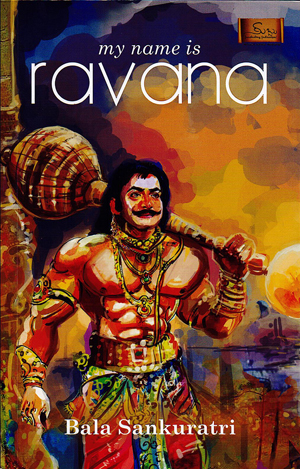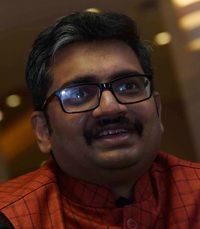A “techy guy” unravelling the Ramayana
 Bala Sankuratri was a self-avowed Indian “techy guy” before he was converted by Ravana into a full-time searcher after that eastern Holy Grail: the truth about the Ramayana. He was travelling in Lanka where the ‘demon’ king, the abducted Sita Devi and Hanuman are all embedded into the landscape with hoary toponymy – whether in traditional highlands with waterfalls, rock caves and kovils or the dry zone with memories of Ravana’s forts over which now the Indian ocean roars. Bala was forever claimed by the great mystery; what really happened in that twilight age?
Bala Sankuratri was a self-avowed Indian “techy guy” before he was converted by Ravana into a full-time searcher after that eastern Holy Grail: the truth about the Ramayana. He was travelling in Lanka where the ‘demon’ king, the abducted Sita Devi and Hanuman are all embedded into the landscape with hoary toponymy – whether in traditional highlands with waterfalls, rock caves and kovils or the dry zone with memories of Ravana’s forts over which now the Indian ocean roars. Bala was forever claimed by the great mystery; what really happened in that twilight age?
He lays before me evidence that proves that, while details may be allegorical and symbolic, the core of this tale has some truth – there must have been a battle (in the style of Troy and Helen?) between an Indian kingdom and Lanka. There is a solid nugget of history though now decorated and embedded with the patterns of the many lands through which the story has travelled.
Bala is a member of the Ayodhya Research Institute which as part of the Uttar Pradesh Government has the aim of collating all the information on the Ramayana from across the world, making a corpus. He is also convener of the Global Encyclopedia of the Ramayana, working on the Sri Lankan chapter.
Seated at a Colombo hotel last month, he provided me with some insight into the ‘historical Ramayana’ as it is perceived now by the Ayodhya Institute.
Written by Valmiki as early as 2700 years ago, the Ramayana was originally not a religious text but “purely historical” though narrated as a story. It was only in later centuries, especially from 14th to 16th, when this mother of eastern epics was simplified into regional dialects of the subcontinent that religious elements were added, and Rama was deified while Ravana, effectively demonised.
Also, when the Ramayana was dramatised by travelling theatres caravanning across rural India, there were at least 30 to 40 nights in one place and a ‘cliff-hanger’ was needed for each night, so drama was added, and the long boring details cut off.
Among the parts of the Ramayana not there in the original texts is the Lakshmana Rekha – the brother-in-law Lakshmana drawing a magical line around Sita to protect her – which line she crosses tricked by Ravana dressed as a muni.
‘Mammoth evidence’ that the Ramayana was true can be inferred from the Sundara khanda or the fifth book where Hanuman, in the midst of being effusive about Lanka, mentions seeing four-tusked elephants here. This detail says Bala refers to the Gomphotheres or a species that became extinct some 11,500 years ago. This indicates that Hanuman visited Lanka when the animals were on the verge of extinction.

Bala Sankuratri
There is too what Ramayana enthusiasts call Sugriva’s Atlas. When Sugriva the king of the apes sent armies to all directions to scout for Sita, he gave instructions as to what they would come across. 70 to 80 percent of this narrative matches the world map as known today.
“I correctly locate Myanmar, the Andaman Islands, Indonesia, Peru and other countries of South America – Sugriva even tells about a marking on a mountain in Peru which is still in existence.
“Going towards the West he travels till the Alps, and towards the south till Antarctica.”
Incredible details like Kumbhakarna sleeping for long periods are also explained.
Bala says that this is a condition called the Kleine Levin Syndrome or the sleeping beauty disorder which makes people live for extraordinarily long periods and the cure for this is for them to live in a low-lit area with purified air, which matches with Ravana’s own cure for his brother in the text.
Astro-dating – determining history by what the skies were like at a period, has helped authenticate the Ramayana. In 500 instances the Ramayana describes what the constellations were like at that particular point.
Using an astronomical dating software scientists were able to ascertain that all the constellations are in a flow; so the story is indeed authentic.
Also intriguing are the toponymical connections. Among the lesser known are Rumassala (named after Ruma the wife of Sugriva) and Matale near Laggala where the charioteer of Indra (and also of the local Sakra) Matali came to help Rama.
Many are the fascinating discoveries being made by the researchers of the Ayodhya Institute, even in such far flung places as Bali and Trinidad where the legends have spread to. It seems that the more technology advances, the easier the task of these sleuths.
Bala Sankuratri’s new book My Name is Ravana will be available in Sri Lanka soon. Mr. Sankuratri also hosted a training programme called Ramayana Yathra for tour operators interested in the important sites of the Ramayana trail.
Searching for an ideal partner? Find your soul mate on Hitad.lk, Sri Lanka's favourite marriage proposals page. With Hitad.lk matrimonial advertisements you have access to thousands of ads from potential suitors who are looking for someone just like you.


